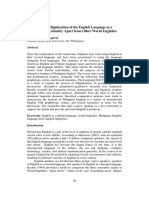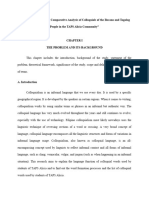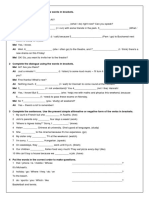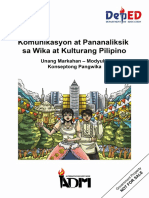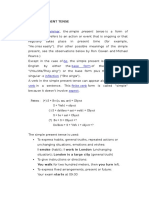Phonological Features of Basilectal Philippine English: An Exploratory Study
Phonological Features of Basilectal Philippine English: An Exploratory Study
Uploaded by
Itsme nnejCopyright:
Available Formats
Phonological Features of Basilectal Philippine English: An Exploratory Study
Phonological Features of Basilectal Philippine English: An Exploratory Study
Uploaded by
Itsme nnejOriginal Description:
Original Title
Copyright
Available Formats
Share this document
Did you find this document useful?
Is this content inappropriate?
Copyright:
Available Formats
Phonological Features of Basilectal Philippine English: An Exploratory Study
Phonological Features of Basilectal Philippine English: An Exploratory Study
Uploaded by
Itsme nnejCopyright:
Available Formats
Presented at the DLSU Research Congress 2016
De La Salle University, Manila, Philippines
March 7-9, 2016
Phonological Features of Basilectal Philippine English: An Exploratory
Study
Eden Regala-Flores, PhD
Department of English and Applied Linguistics
De La Salle University, Manila
eden.flores@dlsu.edu.ph
Abstract: This paper attempts to describe the result of a data-based investigation of
the phonology of the basilectal Philippine English as a response to Tupaz’ (2004)
challenge to conduct Philippine English studies that would describe not only the
“educated English” (the acrolect and mesolect speakers), but the “linguistic practices
of genuinely marginalized voices (the basilect speakers) in Philippine society” (p.54),
as described by Llamzon, 1997 in Tayao, 2004). The findings of this study provide a
description of the phonological features of these “marginalized” voices that include
minimally functionally literate Filipinos such as jeepney drivers, nannies, janitors,
market vendors, and the like from a particular region and Visayan language variety
– Cebuano speakers from Region 7 – to distinguish it from the previous studies that
have usually sampled subjects of Luzon origin only. Finally, the paper echoes the call
for future studies of Philippine English phonology describing the range of segmental
and suprasegmental features of various basilectal PE speakers across the country.
Key Words: phonology; sociolinguistics; Philippine English; basilectal speakers
Proceedings of the DLSU Research Congress Vol 4 2016
ISSN 2449-3309
Presented at the DLSU Research Congress 2016
De La Salle University, Manila, Philippines
March 7-9, 2016
1. INTRODUCTION English, which he then entitled Standard
Filipino English. After claiming that “there is a
As the additional and official language standard variety of English which has arisen
of Filipinos, Philippine English (henceforth, in the Philippines [and it] stands or falls short
PE) has its distinct characteristics, functions, on the premise that there is a sizeable number
and forms different from other World of native and near-native speakers of English
Englishes like, for example, Singaporean in the country” (p. 84), he then sketched the
English, Malaysian English, and Thai English structure of Standard Philippine English (SPE)
(Kachru, 1992). Moreover, its acceptance and based on the utterances of the representative
legitimacy lie in the fact that English has speakers identified, alongside his identification
penetrated the historical, functional, of representative speakers of SPE and their
sociocultural, as well as the creative processes norms of acceptability as well as his
or contexts of the Filipinos (Kachru, 2004). recommendation to target SPE in the teaching
Historically, language policies of the country of English rather than General American
have been formulated and revised time and English (GAE). His sketch of the structure of
again to accommodate the use of English in the SPE primarily dealt with the phonology of the
educational system and to establish its place in then purported (standardized) variety, hoping
such contexts. As an official language, English that someone would later on come up with a
is used in various domains of function, which dictionary of Filipinisms, or “English
may include schools, mass media and World expressions which are neither American nor
Wide Web, business and commerce, or British, which are acceptable in Filipino
government offices. The use of English in educated circles, and are similar to expression
these domains contribute to the acculturation patterns in Tagalog” (p. 46).
of English and its “native” speakers’ ways of Amidst the criticisms that were thrown
life, belief system, etc., into the Filipinos’ against the bold proposal of Llamzon (1969), it
psyche and culture—changing, transforming, could be said that the study of and scholarship
or altering their sociocultural face or identity. in the emerging variety of English in the
In the same vein, the various literary genres, Philippines came to be among the most
professional genres, and news media have been pursued in linguistics in the Philippines.
influenced by the conscious adaptation of the Llamzon (1997) attempted to describe
English language by the Filipinos. the phonology of the various groups of Filipino
1.1 Review of literature English speakers, which he categorized as
As a legitimate and institutionalized acrolect (considered formal and high-style),
variety of World Englishes (Kachru, 2004), PE, mesolect (falls somewhere between the prestige
particularly its sound system, has received of the acrolect and the informality of the
considerable attention from scholars. Attempts basilect; often the most widely spoken form of a
at providing a description of the phonology of language, generally being used by the middle
PE started with Llamzon’s (1969) class), and basilect (typically differ from the
groundbreaking publication on Philippine standard language in pronunciation,
Proceedings of the DLSU Research Congress Vol 4 2016
ISSN 2449-3309
Presented at the DLSU Research Congress 2016
De La Salle University, Manila, Philippines
March 7-9, 2016
vocabulary, and grammar, and can often 54). These marginalized voices (i.e., the
develop into different languages; a variety of a basilectal speakers in this study) include
language used by people from a particular minimally functionally literate Filipinos such
geographic area) following Strevens’ (1982) and as jeep and tricycle drivers, nannies, janitors,
Platt and Weber’s (1980) terms for the and the like, whose speech patterns in English
speakers’ styles of talking (p. 44). need to be described.
In his paper, he described the This study was set to provide an initial
segmental features (production of vowels and description of the phonology of basilectal PE,
consonant sounds) of the three groups of particularly the Cebuano speakers from Region
Filipino speakers vis-à-vis their American 7 (Cebu, Bohol, Siquijor, and Negros Oriental)
counterparts. residing in Metro Manila. The researcher
Following Llamzon’s (1997) group hopes that the findings of this study may
representative speakers of Philippine English, enrich the literature on the phonology of
Tayao (2004) conducted a data-based study in Philippine English as a legitimate variety of
an attempt to describe the distinctive World Englishes.
phonological features shared in and between Answers to the following questions
speakers of the three groups. Her study also would be given, after an analysis of the English
showed that among the basilectal speakers, the of some 48 Cebuano individuals:
vowel inventories among Cebuano and Visayan 1. How may basilectal Philippine
speakers showed only three vowels as utilized English be described in terms of its
by the speakers coming from this group segmental features such as vowels
representative. She added, however, that and consonants?
among basilectal Tagalog speakers, a five- 2. How may basilectal Philippine
vowel system would be realized and utilized. English be described in terms of its
1.2 Research aims suprasegmental properties such as
Tupas (2004), however, posits that stress and intonation patterns?
while these descriptive studies provide some
insights into the phonological features of 2. METHODOLOGY
Philippine English, their overemphasis on
mesolectal and acrolectal (or the so-called 2.1 The respondents
Given the exploratory nature and purpose of
educated) speakers fails to give an adequate this study, which is to provide an initial description
picture of the sound system of this variety of of the basilectal Philippine English, this study only
English. He laments this incomplete revolved around the description of the English as
spoken by 48 subjects – 20 male and 28 female. Most
description in arguing that “by focusing simply of them are ages 23 to 32, but their ages range from
on ‘educated’ English, studies on Philippine 18 to 52. All of them grew up in Cebu, Bohol, Negros
English have lent themselves towards elitist Oriental, and Siquijor and only moved to Manila
later in their life (i.e., after seven years old of age).
(socio) linguistics by almost completely
Thus, all of them have Cebuano as their native
ignoring the linguistic practices of genuinely language with Tagalog and English as additional
marginalized voices in Philippine society” (p. languages acquired later in their lives. It should be
highlighted here that the choice of Cebuano as the
Proceedings of the DLSU Research Congress Vol 4 2016
ISSN 2449-3309
Presented at the DLSU Research Congress 2016
De La Salle University, Manila, Philippines
March 7-9, 2016
substrate language in the current study was the critical segmental and supra-
deliberate: to distinguish it from the previous
studies that have usually sampled subjects of Luzon segmental features. A sampling of those
origin only. This should allow for testing the words and expressions are found in the
possibility of language-specific influences – if any –
Appendix of this paper. The subjects were
to the phonology of (basilectal) PE.
The subjects use English only at work or in tape recorded while reading those words
school and they claim fair English proficiency across aloud. The resulting tape recordings were
the four language macro-skills. Details of their self-
ratings of their English language proficiency are then transcribed following the IPA
reported in Table 1: Phonetic Alphabet.
Figures and tables should be referred to in
the text. They should be centered as shown below
and must be of good resolution. Where equations are 2.2 Data Collection
used, adequate definition of variables and The researcher replicated the data
parameters must be given, as shown in the example
below. collection procedure used by Tayao (2004)
Table 1 and Llamzon (1997).
Self-ratings of the English Proficiency of The data were collected between
the Respondents January and April 2008 in the researcher’s
Macro- Very good Good Fair Poor university and other major cities within
skill f % f % f % f % Metro Manila (e.g., Manila, Parañaque,
2.6 21. 52. 23.
Reading 1 3 11 05 27 63 9 68
Quezon City, Pasig, Las Piñas,
0.0 31. 52. 15. Mandaluyong). The data were gathered
Writing 0 0 13 58 28 63 7 79
0.0 21. 63. 15.
using a two-part instrument (see Appendix
Speaking 0 0 8 05 32 16 8 79 C for the Profile Sheet used in this study).
0.0 36. 57. 5.2
Listening 0 0 18 84 28 89 2 6 The first part aimed to profile the
respondents’ personal information solicited
The subjects work as drivers, their names, age, sex, province, age
vendors, security guards, and household transferred to Manila, occupation, highest
helps, among others, and the majority of educational attainment, monthly income,
them earn Php2, 100 - Php6, 000 per and frequency of use of English in
month. More than half of them completed indicated domains (home, workplace,
the prescribed secondary education but a church, market, etc). It also revealed their
lot still did not, with only one being able to own assessment of their English
see but not finish college. These have proficiency in terms of listening, speaking,
qualified them to be basilectal speakers of reading, and writing. Anybody who did
PE. not meet the requirements: 1) Cebuano-
After selection, the subjects were speaker from Cebu, Bohol, Siquijor, and
asked to read aloud a list which contains Negros Oriental; and 2) transferred to
words and expressions that makes use of Manila at least after their seventh year,
Proceedings of the DLSU Research Congress Vol 4 2016
ISSN 2449-3309
Presented at the DLSU Research Congress 2016
De La Salle University, Manila, Philippines
March 7-9, 2016
were not considered as legitimate/qualified provided by the researcher, this was
respondents. dropped because the researcher observed
The second part of the data- that during the pilot testing of the data-
collection instrument elicited from the collection instrument, respondents
respondents examples of their spoken demonstrated discomfort, uneasiness, and
English, which were recorded on audio embarrassment that resulted in prolonged
tapes. They were requested to read aloud silence and the expressed request/ decision
a list which contains words and not to participate in the research anymore.
expressions that makes use of the critical In view of this development, the
segmental and supra-segmental features. researcher settled to adapt the procedures
Speech samples of the select seven groups used by Tayao (2004) and Llamzon (1999)
of exemplars of this variety of Philippine in their respective studies.
English were elicited using the following
techniques: (1) oral reading of a list of 3 FINDINGS AND DISCUSSION
words containing critical vowel and 3.1 The segmental analysis of basilectal
consonant sounds, (2) oral reading of a list PE
of words with “distinctive” stress 3.1.1 The Consonants
placements, and (3) oral reading of a Noted in the results are the
structured dialogue for intonation pattern. deviation from some GAE consonant
A sampling of those words and expressions inventories particularly in the production
are found in the Appendix of this paper. of fricatives at the labiodental, interdental,
The resulting tape recordings were then and alveolar points of articulation. It may
transcribed following the IPA Phonetic be worth mentioning here that the basilect
Alphabet (2005). Following the Cebuano respondents in this study do not
transcriptions of the recordings, analysis differ from their mesolect and basilect
and description of the distinctive counterparts in Llamzon’s study (1997, p.
phonological features of the basilect PE 46) and Tayao’s (2004, p. 82) in terms of
ensued based on the frequency of consonant inventories. This could be
occurrences of a given phonological attributed to the fact that Filipinos in
feature. The researcher looked for trends general do not tend to aspirate these STOP
across seven groups of respondents. consonants (i.e., /p/, /t/, /k/), substitute /t/
Although an attempt was made to for /θ/ (voiceless) and /d/ for the (/ð/
include a novel way to elicit spoken (voiced), among other substitutions.
English from the respondents, an Llamzon (1997) stated that although
impromptu speech where respondents “Filipinos are willing to copy GAE, they
were to answer a speaking prompt retain something of their identity—in their
Proceedings of the DLSU Research Congress Vol 4 2016
ISSN 2449-3309
Presented at the DLSU Research Congress 2016
De La Salle University, Manila, Philippines
March 7-9, 2016
lack of nasal twang, in the careful 3.1.2 The Vowels
articulation of individual syllables, and in It is interesting to note that this
their refusal to use the ‘reduced signals’ of group of respondents for basilect PE
the informal conversational style of GAE” speakers yielded different results
(p. 43). In the same vein, one can argue compared to previous studies conducted
that Filipino speakers, be they acrolect or where the representation of the basilectal
basilect, at some point, decide not to follow vowel system of many Cebuano and
or speak like a ‘native’ American so long as Visayan speakers of English are described
they can be understood or are able to as utilizing “only three vowels” ( Cf. Tayao,
communicate their ideas, feelings, or 2004, p. 84; Llamzon, 1997, p. 47), there is
desires. This is also true for other Asian a noted production or realizations of other
speakers of English. The phonological vowel sounds as in the case of /ɛ/ and /ɔ/ in
system of the General American English or words like lend and Paul; /e/ and /ʊ/ in
even the British English serves as a guide instances like gate and to . Although not
and is not meant to be strictly mimicked or fully or distinctly realized, the results of
aimed at. However, a closer look at the this study indicate that there are
consonant inventories of the respondents occurrences where speakers were able to
in this study confirms a general notion produce the ten vowel sounds.
that lack of training/exposure to the Realizations of these variants of vowel
language may have greatly contributed to sounds could have been made possible by
their inabilities to produce the sounds the exposure to American music, movies,
under study. It may be worth reiterating and other forms of media to which all
here that most of the respondents are high respondents confirmed listening to or
school graduates. Nevertheless, given the watching. Likewise, news reports over
number of years they have been exposed to local channels could have been responsible
the English language (ten years, if we go for these productions, for although
by the Department of Education’s majority of the news reports are now in
Bilingual Policy in effect now), it is still Filipino, presence of English words,
sad (to say the least) that these phrases, and idiomatic expressions are
phonological features have not been interspersed in the news. The advent of
mastered or at least learned by them. Of text messaging could also be an
course one can always argue that their intervening factor for respondents admit
ethnic tongue forms the substratum which passing on or forwarding English
is responsible for the substitutions or mis- quotations they regularly receive.
production of these sounds.
Proceedings of the DLSU Research Congress Vol 4 2016
ISSN 2449-3309
Presented at the DLSU Research Congress 2016
De La Salle University, Manila, Philippines
March 7-9, 2016
3.2 The suprasegmental analysis of rules discussed above (e.g., rising-falling
basilectal PE intonation where simple statement of
3.2.1 Stress facts, commands or requests, or request for
The investigation of the word stress an information involving the wh-questions
among the basilectal PE speakers for this and the rising-rising pattern involved in
study was made possible through the oral yes-no questions are concerned). However,
reading of a list of words with “distinctive” analyzed from a global or macro level
stress placements compared to GAE. The perspective, the transcribed data would
second part of the data-collection reveal that the respondents in this study
instrument facilitated elicitation of these do not fully reflect nor realize the GAE
data via audio recordings which in turn intonation pattern because of the staccato
were transcribed and analyzed. or disjointed reading of the structured
Generally, the basilectal PE stress dialogue. The natural flow of tones and
pattern differs greatly from its GAE the constancy of the rise and fall of the
counterpart, as seen especially in the cases voice among the basilectal group may not
where three- and four-syllable words like fully reflect the GAE intonation pattern as
percentage, honorable, cemetery, a whole. What makes the findings of this
ceremony, and elementary. However, this study interesting is the fact that they were
study revealed a slight change in the able to raise and lower their voices in the
placement of primary stress on the second instances cited above. Again, this only
syllable of the word utensil where the suggests that further studies be done
basilectal group in other studies placed it before a set of intonation patterns
on the first (cf. Tayao, 2004, p. 85). This characteristic of the basilectal PE
only suggests that until further phonology be established.
comprehensive studies are conducted with
regard to stress patterns of basilectal 4. CONCLUSIONS
speakers, no conclusive claims can be
This paper has attempted to
made in relation to this suprasegmental
provide an initial description of the
feature of PE phonology. phonology of the basilectal Philippine
English focused on the Cebuano speakers
3.2.2 Intonation living within Manila and its surrounding
On the discrete-point or micro level, cities in response to the challenge posed
the intonation pattern of the basilectal by Tupas (2004) with regard to the
group investigated in this study does not incomplete description, if not a dearth of
studies, involving “the linguistic practices
vary from the GAE intonation pattern,
of genuinely marginalized voices in
especially in the realizations of the general
Proceedings of the DLSU Research Congress Vol 4 2016
ISSN 2449-3309
Presented at the DLSU Research Congress 2016
De La Salle University, Manila, Philippines
March 7-9, 2016
Philippine society” (p. 54), such as 6. REFERENCES
jeepney and tricycle drivers, nannies,
janitors, and the like. Bautista MLS, Gonzalez AB (2006). Southeast Asian
English. In B. B. Kachru, Y. Kachru, & C. L.
Findings from this study seem to Nelson (Eds.), The Handbook of World
suggest that at the segmental and Englishes (pp. 130-144). Malden, MA; Oxford;
suprasegmental level, the Cebuano Victoria, Australia: Blackwell Publishing Ltd.
speakers from Region 7 do not diverge Kachru BB (2004). Asian Englishes: Beyond the
much from the GAE pattern. These Canon. Hong Kong: Hong Kong
University Press.
results seem to reveal (if not challenge) Kachru BB (1992). Models for Non-Native
certain phenomena not observed in Englishes. In B. B. Kachru (Ed.), The Other
previous findings of other studies (Cf Tongue: English Across Cultures (2nd ed.) (pp.
Bautista & Gonzalez, 2006; Tayao, 2004) 48-74). Urbana and Chicago: University of
Illinois Press.
such as non-realizations of the Llamzon TA (1969). Standard Filipino English.
interdental fricatives /f/ and /v/ and Manila: Ateneo University Press
divergence from GAE stress placement of Llamzon TA (1997). The Phonology of Philippine
some words among their respondents. English. In M. L. S. Bautista (Ed.), English is
These developments in the “evolving an Asian language: The Philippine Context
(Proceedings of the Conference held in Manila
phonology” (to borrow Tayao’s term) of on August 2-3, 1996) (pp. 41-48). NSW,
the basilectal PE make this field more Australia: The Macquarie Library Pty Ltd.
exciting and inviting for future research Platt J.T., Weber, H. (1980). English in Singapore
not so much towards the standardization and Malaysia. Petaling Jaya: Oxford University
Press.
of the Philippine phonology but towards a Strevens P (1982). World English and the Worlds
more empirical-based analyses and Englishes or, Whose Language Is It Anyway?
description of the various phonological Journal of the Royal Society of Arts, June:418-
features of the various geographical and 31.
linguistic backgrounds of PE speakers. Tayao MLG (2004). The Evolving Study of
Philippine English Phonology. World Englishes
May this paper be a contribution to more (Special Issue on Philippine English: Tensions
detailed analyses/studies of the phonology and Transitions), 23(1): 77-90.
of basilectal Philippine English. Tupas TRF (2004). The Politics of Philippine
_____________________________________ English: Neocolonialism, Global Politics, and
1 The author is grateful for the grant provided by Post Colonialism. World Englishes (Special
Issue on Philippine English: Tensions and
the University Research and Coordinating Office Transitions). Vol. 23(1): 47
(URCO) as well as for the assistance extended by
colleagues and research assistants in gathering and
transcribing the data. Likewise, the author is
indebted to the valuable comments given by the
reviewers.
2 The following review is primarily based on
Bautista (2000) and Tayao (2004).
Proceedings of the DLSU Research Congress Vol 4 2016
ISSN 2449-3309
Presented at the DLSU Research Congress 2016
De La Salle University, Manila, Philippines
March 7-9, 2016
Proceedings of the DLSU Research Congress Vol 4 2016
ISSN 2449-3309
You might also like
- The Evolving Study of Philippine English by Tayao PDFDocument14 pagesThe Evolving Study of Philippine English by Tayao PDFJobelle Gallardo Agas100% (1)
- Exploring The Filipinization of The English Language in A Digital Age: An Identity Apart From Other World EnglishesDocument15 pagesExploring The Filipinization of The English Language in A Digital Age: An Identity Apart From Other World EnglishesJoshuaNathanaelDaangDumaNo ratings yet
- A Simplified Stem-Based System Description of HiligaynonDocument21 pagesA Simplified Stem-Based System Description of HiligaynonvivichanNo ratings yet
- Reading Activity: The Evolving Study of Philippine English Phonology (Tayao, 2008)Document3 pagesReading Activity: The Evolving Study of Philippine English Phonology (Tayao, 2008)ASHENo ratings yet
- RW - Literature Review FormatDocument24 pagesRW - Literature Review FormatSimmy DhaliwalNo ratings yet
- DayonDocument17 pagesDayonRed Colegado, Jr.No ratings yet
- The Millenials Awarenessand Understandingof Philippine EnglishDocument7 pagesThe Millenials Awarenessand Understandingof Philippine EnglishMia Marry FranciscoNo ratings yet
- Influence of Filipinism To The Spoken Discourse of Selected Grade 9 Students of Los Banos National High School-Batong Malaki, Laguna, Philippines S.Y. 2020-2021Document9 pagesInfluence of Filipinism To The Spoken Discourse of Selected Grade 9 Students of Los Banos National High School-Batong Malaki, Laguna, Philippines S.Y. 2020-2021International Journal of Innovative Science and Research TechnologyNo ratings yet
- Students' Morpho-Pragmatic Awareness of The Codified Philippine English and Millennial Slang As Input To Teaching Vocabulary in Junior High SchoolDocument24 pagesStudents' Morpho-Pragmatic Awareness of The Codified Philippine English and Millennial Slang As Input To Teaching Vocabulary in Junior High SchoolPsychology and Education: A Multidisciplinary Journal100% (1)
- Segmental Features of English Modeled byDocument15 pagesSegmental Features of English Modeled byNate ParkinsonNo ratings yet
- A Framework For Designing A Philippine-English-based Pedagogic Model For Teaching English GrammarDocument31 pagesA Framework For Designing A Philippine-English-based Pedagogic Model For Teaching English GrammarChristian ArtNo ratings yet
- 'Re Marking' FilipinoDocument30 pages'Re Marking' FilipinoMichaella AzoresNo ratings yet
- A Closer Look at Philippine English Word-Formation FrameworksDocument6 pagesA Closer Look at Philippine English Word-Formation FrameworksGat TorenaNo ratings yet
- Almost Final - Thesis PDFDocument57 pagesAlmost Final - Thesis PDFVPE100% (2)
- Derivation and Pluralization of Selected Ilokano Terms: Basic Guide To The Teaching of MTB-MLEDocument5 pagesDerivation and Pluralization of Selected Ilokano Terms: Basic Guide To The Teaching of MTB-MLEGhing SindayenNo ratings yet
- Standard Filipino English Philippine EnglishDocument3 pagesStandard Filipino English Philippine EnglishChristine Breeza SosingNo ratings yet
- The Structure of Ibanag NominalsDocument66 pagesThe Structure of Ibanag NominalsTyco MacNo ratings yet
- Verb Affixation in The Selected Tagalog and Binisaya Songs: A Research PaperDocument19 pagesVerb Affixation in The Selected Tagalog and Binisaya Songs: A Research PaperArleen ColacionNo ratings yet
- Positioning P He in Four Discourse QuadrantsDocument21 pagesPositioning P He in Four Discourse QuadrantsFrances Ian Clima100% (1)
- A Tale of Language Ownership and Identity in A Multilingual SocieDocument15 pagesA Tale of Language Ownership and Identity in A Multilingual SocieShaukat Raqueeba ArsadNo ratings yet
- PhilE Lectal SpeakersDocument15 pagesPhilE Lectal SpeakersTeri An Joy MagpaleNo ratings yet
- Philippine Linguistics: The State of The Art: 1970-1980Document49 pagesPhilippine Linguistics: The State of The Art: 1970-1980Roc-Haidee Guro BantogNo ratings yet
- Lim 2011 Tone in Singlish. Substrate Features From Sinitic and Malay (Creoles, Their Substrates, and Language Typology)Document17 pagesLim 2011 Tone in Singlish. Substrate Features From Sinitic and Malay (Creoles, Their Substrates, and Language Typology)高橋 英海.No ratings yet
- All Research Reports Use Roughly The Same FormatDocument10 pagesAll Research Reports Use Roughly The Same FormatniearfaNo ratings yet
- 1788 8595 1 PB PDFDocument13 pages1788 8595 1 PB PDFKen PangilinanNo ratings yet
- Acceptability of Philippine English Grammatical and Lexical Items Among Pre-Service TeachersDocument28 pagesAcceptability of Philippine English Grammatical and Lexical Items Among Pre-Service TeachersDanilo Siquig Jr.No ratings yet
- Nativization of English in Malaysia and The Philippines As Seen in English Dailies Maya Khemlani DavidDocument13 pagesNativization of English in Malaysia and The Philippines As Seen in English Dailies Maya Khemlani DavidPattsie AlitaNo ratings yet
- A Bibliography of Philippine Linguistics 1996Document370 pagesA Bibliography of Philippine Linguistics 1996Jiara Montaño83% (6)
- A Grammar of Mëranaw LanguageDocument8 pagesA Grammar of Mëranaw LanguageInternational Journal of Innovative Science and Research Technology100% (1)
- Philippine Linguistics JouralDocument151 pagesPhilippine Linguistics JouralDynise Aubrey TorralbaNo ratings yet
- Philippine English Vocabulary by PorciunculaDocument14 pagesPhilippine English Vocabulary by PorciunculaRio CustodioNo ratings yet
- Research NotesDocument26 pagesResearch NotesVenniecine LopezNo ratings yet
- From English and Filipino To Zamboanga Chavacano: Finding The Missing VoiceDocument21 pagesFrom English and Filipino To Zamboanga Chavacano: Finding The Missing VoiceRab'a SalihNo ratings yet
- Language Attitudes of English Language Teachers Towards Philippine EnglishDocument27 pagesLanguage Attitudes of English Language Teachers Towards Philippine EnglishhuynhthaithunganNo ratings yet
- Community-Based Descriptive Orthography of SurigaoDocument13 pagesCommunity-Based Descriptive Orthography of SurigaoHarrold GalloNo ratings yet
- Gonzales 2017 Philippine EnglishesDocument19 pagesGonzales 2017 Philippine EnglishesmkassandrajalaniNo ratings yet
- English Es in College English TextbooksDocument26 pagesEnglish Es in College English Textbooks玫伊No ratings yet
- Tagalog, Bahasa Indonesia, and Bahasa Melayu Language: A Comparative AnalysisDocument21 pagesTagalog, Bahasa Indonesia, and Bahasa Melayu Language: A Comparative AnalysisPsychology and Education: A Multidisciplinary JournalNo ratings yet
- Review of Related Literture AndstudiesDocument4 pagesReview of Related Literture AndstudiesShahani Cel MananayNo ratings yet
- Module 1Document10 pagesModule 1LARREN JOY CASTILLONo ratings yet
- Share Filipino English_Pronunciation in relation to genderDocument13 pagesShare Filipino English_Pronunciation in relation to genderCatherine TolentinoNo ratings yet
- T'Boli Tourism English in Lake Sebu, South CotabatoDocument9 pagesT'Boli Tourism English in Lake Sebu, South CotabatoPsychology and Education: A Multidisciplinary JournalNo ratings yet
- MALC 1971 1-7 Asuncion LandeDocument7 pagesMALC 1971 1-7 Asuncion LandeRachelle LlagasNo ratings yet
- Emergence of Philippine English: Seeing It From The Cultural PerspectiveDocument6 pagesEmergence of Philippine English: Seeing It From The Cultural PerspectiveTJPRC PublicationsNo ratings yet
- Elt 224 - Week 1-3Document21 pagesElt 224 - Week 1-3Sofia NicoleNo ratings yet
- Chapter 1 Introduction 1.1. BackgroundDocument9 pagesChapter 1 Introduction 1.1. BackgroundTya Eve PapawNo ratings yet
- The Filipino Monolingual Dictionaries and The Development of Filipino LexicographyDocument33 pagesThe Filipino Monolingual Dictionaries and The Development of Filipino LexicographyCheka CurativoNo ratings yet
- A Grammar of Bisaya in DavaoDocument6 pagesA Grammar of Bisaya in DavaoInternational Journal of Innovative Science and Research Technology100% (1)
- Emerging South-East Asian Englishes and IntelligibilityDocument19 pagesEmerging South-East Asian Englishes and Intelligibilitym_linguistNo ratings yet
- Inbound 730628068742346620Document12 pagesInbound 730628068742346620William EllenNo ratings yet
- A New Approach To The Teaching of English in The PhilippinesDocument10 pagesA New Approach To The Teaching of English in The PhilippinesMatt ChenNo ratings yet
- Morphological Doubling Theory To Two BanDocument10 pagesMorphological Doubling Theory To Two BanGabriel BazimazikiNo ratings yet
- From Filipino and English To Zamboanga Chavacano: Finding The Missing VoiceDocument20 pagesFrom Filipino and English To Zamboanga Chavacano: Finding The Missing VoiceClark JoshuaNo ratings yet
- Literature Review Non Native SpeakersDocument8 pagesLiterature Review Non Native SpeakersCatalina GutierrezNo ratings yet
- Reseacrh ProposalDocument11 pagesReseacrh ProposalLeona Nicole EsguerraNo ratings yet
- Morphophonemic Variation Among Kinamayo Dialects - A Case StudyDocument18 pagesMorphophonemic Variation Among Kinamayo Dialects - A Case StudyAlfeo OriginalNo ratings yet
- A Bibliography of Philippine Linguistics - SIL InternationalDocument370 pagesA Bibliography of Philippine Linguistics - SIL Internationalstojce stojcevNo ratings yet
- The English Linguistics Project: English Manual (8th Edition)From EverandThe English Linguistics Project: English Manual (8th Edition)Rating: 5 out of 5 stars5/5 (3)
- Writing I Freewriting Putting Things TogetherDocument1 pageWriting I Freewriting Putting Things TogetherValberto AraujoNo ratings yet
- Direct Indirect SpeechDocument3 pagesDirect Indirect SpeechDanarDharmawan0% (1)
- Describing ProcessesDocument11 pagesDescribing ProcessesrenagatesNo ratings yet
- Toeic Speaking CourseDocument1 pageToeic Speaking CourseTrang Hoang MinhNo ratings yet
- Making ComparisonsDocument11 pagesMaking ComparisonsLisberth ChristinaNo ratings yet
- English For Call CentersDocument11 pagesEnglish For Call CentersventilationNo ratings yet
- Grammar in Practice 1Document3 pagesGrammar in Practice 1Karls LuisNo ratings yet
- A1-Unit 5Document2 pagesA1-Unit 5Monica CortesNo ratings yet
- Subject-Verb Agreement RulesDocument3 pagesSubject-Verb Agreement RulesEl Gio EstradaNo ratings yet
- FP Comunicacion y SociedadDocument9 pagesFP Comunicacion y SociedadCarmen Pănuță100% (1)
- 1complete The Dialogue Using The Words in Brackets 1,2Document4 pages1complete The Dialogue Using The Words in Brackets 1,2Cristina GarciaNo ratings yet
- Word Stress - SuffixDocument4 pagesWord Stress - SuffixHung Thuyen PhamNo ratings yet
- Have GotDocument2 pagesHave GotVania RomeroNo ratings yet
- Past Tenses TheoryDocument4 pagesPast Tenses TheoryÁngela Naranjo GómezNo ratings yet
- Writing Lesson-PlanDocument2 pagesWriting Lesson-Planapi-338739762No ratings yet
- Repase y Escriba 45Document1 pageRepase y Escriba 45angel galindoNo ratings yet
- Prepositions - PPT 2Document19 pagesPrepositions - PPT 2ఫణి ఆచార్యNo ratings yet
- Characteristics of The Linguistic SignDocument2 pagesCharacteristics of The Linguistic SignCeleste PascualNo ratings yet
- 15 English Words Phrases You May Be Saying WronglyDocument12 pages15 English Words Phrases You May Be Saying Wronglyfazlen.socialmediaNo ratings yet
- WEEKLY LEARNING PLAN Q1 Wk5Document3 pagesWEEKLY LEARNING PLAN Q1 Wk5Jane DagpinNo ratings yet
- 7.-sinif-ingilizce-1.-donem-1.-yazili-sorulari-acik-uclu-senaryo-1Document1 page7.-sinif-ingilizce-1.-donem-1.-yazili-sorulari-acik-uclu-senaryo-1saltanat.orozalievaNo ratings yet
- Complementary DistributionDocument2 pagesComplementary DistributionAbraham ReyNo ratings yet
- Pronoun: Aira Dita Ricki Prisma P Rindu Nurani Vasya Olivia Ezra FebrianDocument14 pagesPronoun: Aira Dita Ricki Prisma P Rindu Nurani Vasya Olivia Ezra FebrianVasya OliviaNo ratings yet
- A2 Grammar - Gerunds and InfinitivesDocument4 pagesA2 Grammar - Gerunds and InfinitivesSamer dawanNo ratings yet
- Komunikasyon at Pananaliksik11 - q1 - m1 - Konseptong Pangwika - v3Document21 pagesKomunikasyon at Pananaliksik11 - q1 - m1 - Konseptong Pangwika - v3Kryssss100% (1)
- 3º ESO BIL - U4 - Future TensesDocument16 pages3º ESO BIL - U4 - Future Tensesascen2175No ratings yet
- Perfect English Grammar - Future PerfectDocument3 pagesPerfect English Grammar - Future Perfectanacristinamachado943No ratings yet
- English Grammar Verb: Simple Present TenseDocument5 pagesEnglish Grammar Verb: Simple Present TenseJoebaili MuhammadNo ratings yet
- Linker NotesnquestionsDocument10 pagesLinker NotesnquestionsJuanna IsmailNo ratings yet
- UNIT THREE SLDocument9 pagesUNIT THREE SLJessa CarreonNo ratings yet

